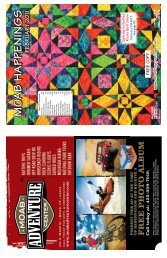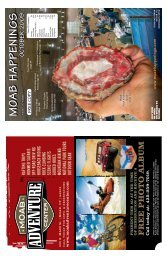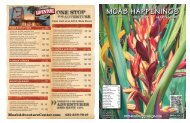Moab Happenings ⢠August 2010
Moab Happenings ⢠August 2010
Moab Happenings ⢠August 2010
Create successful ePaper yourself
Turn your PDF publications into a flip-book with our unique Google optimized e-Paper software.
10B • <strong>August</strong> <strong>2010</strong> • <strong>Moab</strong> <strong>Happenings</strong><br />
The <strong>Moab</strong> area has numerous examples of Indian rock<br />
art to enjoy. This article briefly discusses some types, dates,<br />
the artists and their cultures and how to take care of these<br />
irreplacable sites.<br />
MOAB AREA ROCK ART<br />
www.moabhappenings.com<br />
WHAT IS INDIAN ROCK ART?<br />
There are two types of rock art: petroglyphs (motifs that<br />
are pecked, ground, incised, abraded, or scratched on the rock<br />
surface) and pictographs (paintings or drawings in one or<br />
more colors using mineral pigments and plant dyes on the<br />
rock surface). Although many images may have originally<br />
been executed as a combination of both techniques, most<br />
now appear only as a petroglyph because the paint material<br />
has faded or washed away over many years.<br />
THE PEOPLE<br />
Rock art was produced by a number of prehistoric and<br />
historic peoples over thousands of years. Their histories<br />
in the area are very complex. A big game hunting people,<br />
known as Paleo-Indians, are considered to be the first<br />
human users in the area. Their game included now-extinct<br />
Pleistocene fauna such as mammoths and mastodons. A later<br />
culture called Archaic, probably used central based camps<br />
during their seasonal round of activities based on harvesting<br />
wild plants and animals. They did not build permanent<br />
habitation structures, but lived in caves and in small brush<br />
shelters built in the open.<br />
The Anasazi whose culture centered south of <strong>Moab</strong><br />
in the Four Corners area, concentrated much of their<br />
subsistence efforts on the cultivation of corn, beans and<br />
squash. These sedentary people, also harvested a wide<br />
variety of wild resources, such as pinion nuts, grasses,<br />
bighorn sheep and deer. The Fremont were contemporary<br />
with the Anasazi people, also grew corn, and were apparently<br />
more dependent on hunting and gathering wild resources<br />
than were the Anasazi. Their territory was mainly north of<br />
the Colorado River, but overlapped the Anasazi at <strong>Moab</strong>.<br />
The most recent inhabitants, the Utes have been in<br />
southeast Utah since the 1200’s, They were a very mobile<br />
hunting and gathering people who moved in from the Great<br />
Basin. They used the bow and arrow, made baskets and<br />
brownware -pottery, and lived in brush wickiups and tipis.<br />
The No-tah (Ute people) lived freely throughout western<br />
Colorado and eastern Utah until about 1880.<br />
SITES<br />
If you have trouble locating rock art once you are near a site,<br />
don’t be discouraged. You will develop a sense of which<br />
types of rocks and surfaces are appropriate areas to look for<br />
petroglyphs and pictographs. Petroglyphs are commonly found<br />
on the black or brown surface (called desert varnish) of rock cliffs. The straight, smooth, red sandstone found in the Navajo<br />
and Wingate formations is a good area to look for -pictographs. As you spot one image, look carefully around the adjoining<br />
surface areas. Often there are numerous images at any given site. The main panel might have one or more subpanels nearby.<br />
Some of the images may be very faint, having faded or eroded through the years.<br />
<br />
<br />
<br />
<br />
<br />
<br />
<br />
<br />
<br />
<br />
RACING








